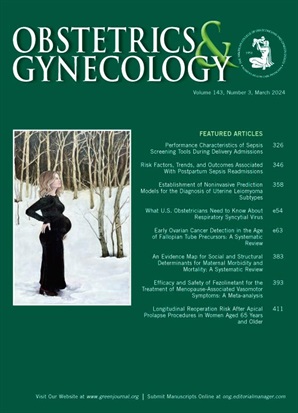Outcomes for Female Physicians Compared With Nonphysicians After Assisted Reproductive Technology.
IF 5.7
2区 医学
Q1 OBSTETRICS & GYNECOLOGY
引用次数: 0
Abstract
OBJECTIVE To evaluate outcomes of female physicians after assisted reproductive technology (ART). METHODS We conducted a retrospective cohort study using data from 248 physician patients and 3,470 nonphysician patients who underwent a total of 10,095 fresh or frozen ART cycles at a single academic center in an insurance-mandated state between January 2015 and March 2022. The primary outcome was live-birth rate. The secondary outcomes were implantation rate, early pregnancy loss rate, and time to pregnancy. Models were adjusted for confounders where appropriate. RESULTS Both groups were similar in age (mean physician age 36.29 years; mean nonphysician age 35.96 years, P=.35). Physicians had lower body mass index (BMI) (mean physician BMI 23.51, mean nonphysician BMI 26.37, P<.01), and a higher proportion were diagnosed with unexplained infertility (physician 33.9%, nonphysician 25.9%, P<.01) and used preimplantation genetic testing for aneuploidy (physician 21.5%, nonphysician 12.7%). Physicians and nonphysicians had similar live-birth rates (physician 39.3%, nonphysician 38.2%; adjusted relative risk [aRR] 1.01 95% CI, 0.91-1.13), implantation rates (physician 34.7%, nonphysician 33.7%; relative risk 1.03 95% CI, 0.94-1.14), and early pregnancy loss rates (physician 21.9%, nonphysician 19.8%; aRR 1.18 95% CI, 0.99-1.41) per transfer. Physicians had a shorter time from initial ART cycle to pregnancy (physician 21.82 weeks, nonphysician 25.16 weeks; aRR 0.86, 95% CI, 0.83-0.89). CONCLUSION There was no difference between female physicians and nonphysicians in assisted reproduction cycle outcomes. Physicians become pregnant slightly faster than nonphysicians.辅助生殖技术后女医生与非女医生的结果比较。
目的评估女医生在接受辅助生殖技术(ART)后的治疗效果。方法我们进行了一项回顾性队列研究,使用了 248 名医生患者和 3470 名非医生患者的数据,这些患者在 2015 年 1 月至 2022 年 3 月期间,在一个有保险规定的州的单一学术中心接受了总共 10095 个新鲜或冷冻 ART 周期。主要结果是活产率。次要结果为植入率、早孕损失率和妊娠时间。两组的年龄相似(医生平均年龄为 36.29 岁;非医生平均年龄为 35.96 岁,P=.35)。医生的体重指数(BMI)较低(医生的平均体重指数为 23.51,非医生的平均体重指数为 26.37,P<.01),被诊断为不明原因不孕症的比例较高(医生为 33.9%,非医生为 25.9%,P<.01),使用植入前非整倍体基因检测的比例较高(医生为 21.5%,非医生为 12.7%)。医生和非医生每次移植的活产率(医生 39.3%,非医生 38.2%;调整后相对风险 [aRR] 1.01 95% CI,0.91-1.13)、植入率(医生 34.7%,非医生 33.7%;相对风险 1.03 95% CI,0.94-1.14)和早孕损失率(医生 21.9%,非医生 19.8%;aRR 1.18 95% CI,0.99-1.41)相似。医生从初始 ART 周期到怀孕的时间较短(医生 21.82 周,非医生 25.16 周;aRR 0.86,95% CI,0.83-0.89)。医生的怀孕速度略快于非医生。
本文章由计算机程序翻译,如有差异,请以英文原文为准。
求助全文
约1分钟内获得全文
求助全文
来源期刊

Obstetrics and gynecology
医学-妇产科学
CiteScore
11.10
自引率
4.20%
发文量
867
审稿时长
1 months
期刊介绍:
"Obstetrics & Gynecology," affectionately known as "The Green Journal," is the official publication of the American College of Obstetricians and Gynecologists (ACOG). Since its inception in 1953, the journal has been dedicated to advancing the clinical practice of obstetrics and gynecology, as well as related fields. The journal's mission is to promote excellence in these areas by publishing a diverse range of articles that cover translational and clinical topics.
"Obstetrics & Gynecology" provides a platform for the dissemination of evidence-based research, clinical guidelines, and expert opinions that are essential for the continuous improvement of women's health care. The journal's content is designed to inform and educate obstetricians, gynecologists, and other healthcare professionals, ensuring that they stay abreast of the latest developments and best practices in their field.
 求助内容:
求助内容: 应助结果提醒方式:
应助结果提醒方式:


